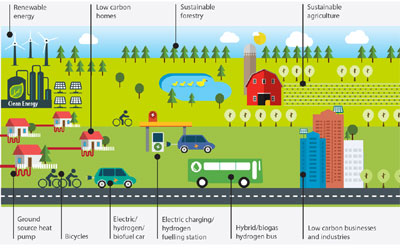As Ontario enshrined its climate plan into law, Environment minister Glen Murray said it “marks the start of the next chapter in Ontario’s transformation to an innovative and prosperous low-carbon economy.”
Canada’s most populous province will spend over $7 billion over the next four years to implement its 57-page Climate Change Action Plan. It contains about 80 policies, each with a price tag, for 2017-2021. The big goal is to cut greenhouse gas emissions 15% by 2020, 37% by 2030 and 80% by 2050, from 1990 levels.
They’ve already shuttered all coal plants and by 2030, fossil fuels, including natural gas, will not be allowed for heating. New building codes require all new homes heated by geothermal or electricity by 2030, and incentives will encourage efficiency upgrades in existing buildings. All homes sold must first have an energy audit. Rebates for electric vehicles will help meet the goal of 5% of all vehicles sold by 2020 and 12% by 2025.
Much of money needed to implement the plan will come from the province’s cap-and-trade program, which starts next year. It will be linked with the Western Climate Initiative, which consists of California and Quebec. A new Green Bank will finance many programs.
What Ontario will look like in 2050, taken from the Climate Change Action Plan:
According to The Globe & Mail:
- $3.8 billion in grants, rebates and other subsidies to retrofit buildings
- Up to $14,000 in rebates to buy an electric vehicle and up to $1000 for a home charger; subsidies for lower income families to get older cars off the road and free overnight electricity to charge vehicles at public outlets. Funding will also help schools switch to electric buses and trucking companies to cleaner trucks. The regional rail network will be enhanced, as will bicycle infrastructure, such as separte bike lanes and parking at train stations. Total cost: $1.1 billion.
- Gasoline and diesel will have to have 5% lower lifecycle emissions by 2020. Natural gas will have to be derived from more renewable sources, such as biogas.
- $375 million for cleantech R&D, about half of which is for a Global Centre for Low-Carbon Mobility.
- $1.2 billion to help industry buy more energy efficient equipment and other measures to reduce emissions.
- $174 million to make the government carbon neutral through building upgrades, telecommuting, and carbon offset purchases.
“By 2050, we envision Ontarians will be using less energy and the energy we do use will be from low-carbon sources. Communities will be climate-resilient, complete and compact. More people will choose electric or other zero-emission vehicles and transit to get swiftly and efficiently where they need to go. Agricultural lands, natural areas and ecosystems will be better protected for the benefit and enjoyment of all, including First Nations and Métis peoples who rely on our shared natural environment for sustainment and spiritual benefit.
“Ontario that will be employing new ways to reduce waste while ensuring that more of the waste produced is reintroduced to the economy. Industries will be thriving while generating fewer or zero emissions. Businesses and innovators will be creating world-leading clean technologies and products that drive new economic growth, productivity, and job creation. We must do it. We can do it. And we will do it, together,” says Murray.
Learn more: http://www.ontario.ca/page/climate-change

